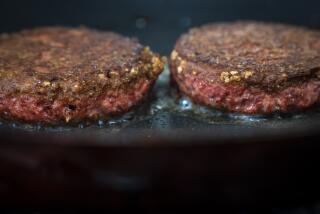Little-Known Rendering Firms Live Off Fat of the Land : Business: Companies collect grease and bone from restaurants and process the substances into materials that are used in soap and pet food.
- Share via
NEW YORK — What doesn’t get eaten at a restaurant might end up on a production line at Colgate-Palmolive or Ralston Purina. Grease, fat, and bone are key ingredients in the soap and pet food industries.
What lies between McDonald’s and the soap factory is a hidden industry, the multibillion-dollar rendering business.
Renderers collect waste and process it into usable materials. There are over 400 rendering plants in the country and the industry has its own trade group, the National Renderer Assn., which publishes a magazine, “Renderer.” Despite this, the rendering industry is a virtually unknown enterprise, what one practitioner calls a “secret industry.”
“No one wants to hear about fat and grease and bone,” said Seymore Berkowitz, owner of Berkowitz Fat Inc. in New Jersey. “It’s not exactly dinner-table conversation.”
Not only has rendering been profitable over the years, it also provides an important environmental service; it saves the country from drowning in waste. According to the Census Bureau, the rendering business processes 50 billion pounds of grease, lard and bones a year, or as one renderer noted, enough to fill the Grand Canyon three times.
Because of its preponderance of restaurants and supermarkets, the New York metropolitan area is the unofficial capital of the rendering business.
“Though there are no official statistics, I think it’s safe to say that New York is the greasiest city in the world,” said Jim Ferguson, collection manager for the Darling Delaware Co. of New Jersey, the largest rendering company in the world.
Three large rendering companies and several smaller ones serve New York City. They range from Darling Delaware, which has more than 8,000 clients, including most of the McDonald’s in the city, to renderers that serve only a few hundred businesses. All are privately owned and will not disclose their revenues.
Most of the rendering companies that serve New York City are located in New Jersey or Long Island. Restaurants and supermarkets pay anywhere from $15 to $30 a month to have waste taken away.
Barrels of waste are loaded on to trucks, which dump the material into large holding tanks at the plants. The tanks heat the waste to thin the congealed material. After the waste has been “rendered,” it is used to produce soap, industrial cleaners, chemical lubricants and pet food.
The rendering business has suffered only slightly in recent years from the health food craze. The grease-collection part of the business has remained steady due primarily to fast-food restaurants. But for those companies that concentrate on animal bone and fat, the past few years have been troubled.
“It is simple supply-and-demand economics,” said Jerome Levy, sales manager for Standard Tallow Inc., which does not collect grease from restaurants. “As people eat less red meat, there is less fat and bone to be had.”
Though grease-collection costs are relatively low, some restaurants view it as an unnecessary expense. Some eating establishments, particularly small, independently owned ones, simply dump grease down the sink, according to Ed Schlagenhaft, plant manager for Darling Delaware.
“The businesses that dump grease down the drain cause a problem for us because we don’t get the grease, and for the environment because the grease contaminates the water,” Schlagenhaft said.
The New York City Department of Environmental Protection, however, said the problem is not very widespread or serious.
“Grease does not contaminate the water because it is in the sewers, not in the waterways,” said Jessica Garcia, supervisor of complaints at Department’s Bureau of Water Supply and Wastewater Collection.
In several cities, including New York, grease theft has become a problem. People steal the storage barrels from behind restaurants and sell them to rendering companies, which are saved the pick-up expense.
But few restaurants press charges since, in fact, the thieves are doing them a favor. The law was enacted when rendering companies paid restaurants and supermarkets for waste, before expenses made the companies reverse the policy.
Despite these problems, the rendering industry will continue to exist. Said Berkowitz: “As long as there’s grease, we’ll be around.”
More to Read
Inside the business of entertainment
The Wide Shot brings you news, analysis and insights on everything from streaming wars to production — and what it all means for the future.
You may occasionally receive promotional content from the Los Angeles Times.









